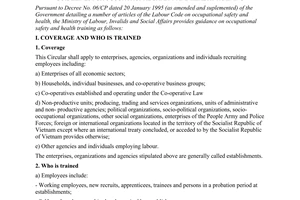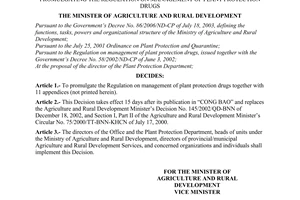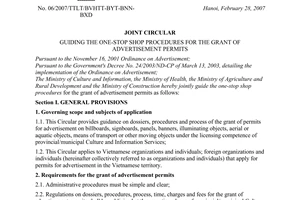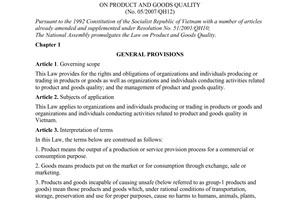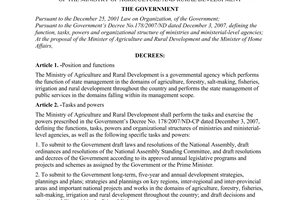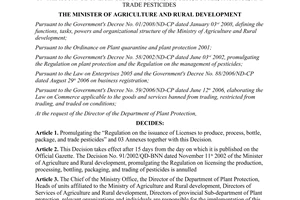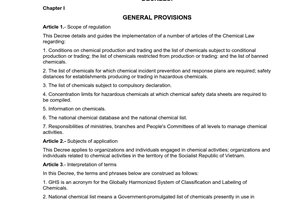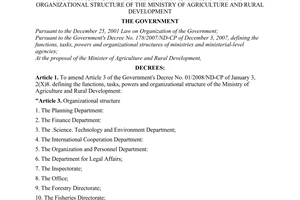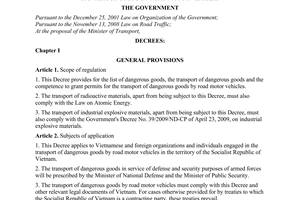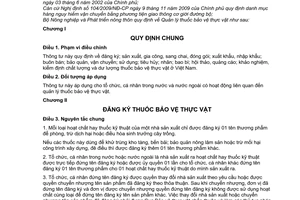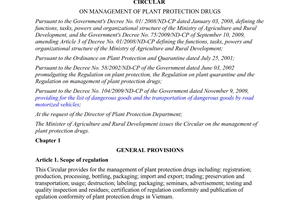Circular No. 38/2010/TT-BNNPTNT providing for the management of plant protection đã được thay thế bởi Circular No. 03/2013/TT-BNNPTNT on management of plant protection drugs và được áp dụng kể từ ngày 25/02/2013.
Nội dung toàn văn Circular No. 38/2010/TT-BNNPTNT providing for the management of plant protection
|
THE
MINISTRY OF AGRICULTURE AND RURAL DEVELOPMENT |
SOCIALIST
REPUBLIC OF VIET NAM |
|
Hanoi, June 28, 2010 |
CIRCULAR
PROVIDING FOR THE MANAGEMENT OF PLANT PROTECTION DRUGS
Pursuant to the Government's
Decree No. 01/ 2008/ND-CP of January 3, 2008, defining the functions, tasks,
powers and organizational structure of the Ministry of Agriculture and Rural
Development, and Decree No. 75/2009/ND-CP of September 10, 2009, amending
Article 3 of Decree No. 01/2008/ND-CP;
Pursuant to the July 25, 2001 Ordinance on Plant Protection and Quarantine;
Pursuant to the Regulation on management of plant protection drugs, issued
together with the Government's Decree No. 58/2002/ND-CP of June 3, 2002;
Pursuant to the Government's Decree No. 104/2009/ND-CP of November 9, 2009,
providing for the list of dangerous goods transported by road motor vehicles;
The Ministry of Agriculture and Rural Development provides for the management
of plant protection drugs as follows:
Chapter 1
GENERAL PROVISIONS
Article 1. Scope of regulation
This Circular provides the registration; production, processing, bottling and packing; import and export; trading; preservation and transportation; use; destruction; labeling; and packaging of; seminars on, and advertisement for; and testing and inspection of quality and residues of. plant protection drugs in Vietnam.
Article 2. Subjects of application
This Circular applies to domestic and foreign organizations and individuals conducting activities related to the management of plant protection drugs.
Chapter II
REGISTRATION OF PLANT PROTECTION DRUGS
Article 3. General principles
1. A producer may register only one trade name for one active ingredient or technical drug used for pest prevention and control or plant growth regulation.
If these drugs are also used for disinfection of storehouses and storing yards; preservation of agricultural or forestry products or as termite killers for construction works and dikes, one more trade name may be registered for each of these drugs.
2. A domestic or foreign organization or individual that produces an active ingredient or technical drug may directly register one trade name for that active ingredient or technical drug or once authorize another to do so.
3. The registering organization or individual may change the producer upon request or transfer the registered trade name under agreement. After the transfer, the registering unit and the unit that is transferred the right to registration may not use the active ingredient of the same type for registering another trade name. The change of producers or transfer of registered trade names is subject to approval of the Plant Protection Department and must go through relevant legal procedures.
4. For registration, all plant protection drugs must pass bio-effect tests in Vietnam. Bio-effect tests shall be conducted under Chapter XII of this Circular.
For official registration or registration of trade names and compounds, plant protection drugs of chemical origin must pass narrow-area and wide-area bio-effect tests.
For official registration or registration of trade names and compounds, plant protection drugs of biological origin must pass wide-area bio-effect tests: for additional registration of usages, dosage, use method, drug formulation or contents of active ingredients, plant protection drugs must pass wide-area bio-effect tests.
5. For first-time registration, plant protection drugs of chemical origin for pest prevention and control (except herbicides for fruit trees and tea), for regulation of the growth of each kind of fruit trees after the period of fructification, tea and vegetable or for post-harvest preservation of farm produce, must be tested to re-determine their isolation duration in Vietnam under Chapter XII of this Circular.
6. For plant protection drugs of chemical origin with active ingredients of group-ITI or -IV acute toxicity prescribed in Sections 1 and 7, Appendix 4 to this Circular (not printed herein) or with active ingredients not belonging to the organic chlorine group and having an isolation duration in Vietnam of up to 7 days, if the results of their bio-effect tests in Vietnam satisfy the prescribed requirements, they may be registered for use for pest prevention and control, regulation of the growth of fruit trees, tea or vegetable or for post-harvest preservation of farm produce.
7. For plant protection drugs which have been separately registered for prevention and control of the same pest, their mixture may be recommended for use. but such mixture may not bear a proper name unless approval of the Agriculture and Rural Development Ministry is obtained.
Article 4. Plant protection drugs subject to use registration in Vietnam
1. Drugs with active ingredients not yet named on the list of plant protection drugs permitted for use in Vietnam;
2. Drugs with active ingredients named on the list of plant protection drugs permitted for use in Vietnam but bearing other trade names;
3. Drugs with trade names on the list of plant protection drugs permitted for use which have their usages and dosage; use method, formulation and contents of active ingredients modified, or which are mixed with other drugs to form new ones.
4. Drugs in the form of finished products of group-I acute toxicity or drugs in the form of finished products of group-II acute toxicity with active ingredients of group-I toxicity prescribed in Sections 1 and 7, Appendix 4 to this Circular which are used for disinfection of storehouses and storing yards; drugs for preservation of forest products; drugs for termite extermination for construction works and dikes: and rodenticides.
Article 5. Plant protection drugs disallowed for use registration in Vietnam
1. Drugs on the list of plant protection drugs banned from use; drugs on the list of plant protection drugs restricted from use in Vietnam for control of field pests.
2. Drugs with active ingredients invented by foreign organizations or individuals but not yet registered for use in foreign countries.
3. Drugs with trade names identical with the names of active ingredients or trade names of registered drugs;
4. Drugs in the form of finished products of group-I acute toxicity or drugs in the form of finished products of group-II acute toxicity with active ingredients of group-I acute toxicity prescribed in Sections 1 and 7. Appendix 4 to this Circular, except those specified in Clause 4, Article 4 of this Circular.
5. Drugs on watch lists of the United Nations Food and Agriculture Organization (FAO) and the United Nations Environment Program (UNEP); and drugs in Annex 3 to the Rotterdam Convention.
6. Drugs containing methyl bromide.
Article 6. Forms of registration
1. Official registration
Official registration applies to:
a/ Plant protection drugs newly created in the country and recognized as plant protection drug by the Plant Protection Department.
b/ Plant protection drugs being commodities in foreign countries but put into use for the first time in Vietnam.
2. Additional registration
Additional registration applies to:
a/ Plant protection drugs with active ingredients similar to those of drugs of other organizations and individuals for which official registration has been made for 3 years since the effective date of the Agriculture and Rural Development Ministry's circular promulgating the list of plant protection drugs.
b/ Plant protection drugs bearing trade names different from those of drugs with similar active ingredients on the list of plant protection drugs permitted for use.
c/ Supplementation of usage and dosage, use method, drug formulation and content of active ingredients;
d/ New products being mixtures of 2 or more active ingredients;
3. Extension of registration
a/ Extension of registration applies to all drugs on the lists of plant protection permitted for use or restricted from use in Vietnam upon expiration of their registration certificates.
b/ Dossiers of registration extension mast be filed at least 3 months before the expiration of registration certificates. Plant protection drugs for which procedures for registration extension are not carried out in time shall be excluded from the lists of plant protection drugs permitted for use or restricted from use in Vietnam.
c/ Plant protection drugs defined in Clauses 4 and 5, Article 5 of this Circular are not entitled to registration extension upon expiration of their registration certificates.
Article 7. Dossiers of registration of plant protection drugs
1. A dossier of official registration comprises:
a/ An application for registration of plant protection drugs, made according lo a form provided in Appendix 1 to this Circular (not printed herein);
b/ An authorization paper of the producer of the active ingredient or technical drug applied for registration;
c/ A written certification (original or lawful copy) of being the producer of the active ingredient or technical drug, issued by a competent management authority of the host country;
d/ Detailed technical documents in Vietnamese or English which are copied or translated from the originals and certified by the producer of the active ingredient or technical drug specified in Appendix 3 to this Circular (not printed herein):
e/ A copy of the registration for use of the drug in foreign countries;
f/ A specimen label of the drug as prescribed in Chapter IX of this Circular;
g/ Results of bio-effect tests and isolation duration tests as prescribed;
h/ Lawful copies of industrial property right protection titles, issued by Vietnam's National Office of Intellectual Property, or a lawful copy of the authorization paper or paper on licensing of industrial property right protection titles of products in Vietnam, made by the owner of these products (if any).
2. Dossiers of additional registration:
a/ For registration of trade names or compounds, the following papers are required:
- An application for registration of plant protection drugs, made according to a form provided in Appendix I to this Circular;
- An authorization paper, issued by the producer of the active ingredient or technical drug applied for registration;
- A written certification (original or lawful copy) of being the producer of the active ingredient or technical drug applied for registration, issued by a competent management authority of the host country;
- Detailed technical documents in Vietnamese or English which are copied or translated from the originals and certified by the producer of the active ingredient or technical drug specified in Appendix 3 to this Circular;
- A specimen label of the drug as prescribed in Chapter IX of this Circular;
- Results of bio-effect tests and isolation duration tests as prescribed;
- Lawful copies of industrial property right protection titles, issued by Vietnam's National Office of Intellectual Property, or a lawful copy of the authorization paper or paper on licensing of industrial property right protection titles of products in Vietnam, made by the owner of these goods (if any).
b/ For supplementation of drug formulation and contents of active ingredients, the following papers are required:
- An application for registration of plant protection drugs, made according to a form provided in Appendix 1 to this Circular;
- The finished products' detailed technical documents in Vietnamese or English which are copied or translated from the originals and certified by the producer of the active ingredient or technical drug specified in Appendix 3 to this Circular:
- A copy of the drug registration certificate;
- The specimen label of the drug as prescribed in Chapter IX of this Circular;
- Results of bio-effect tests and isolation duration tests as prescribed.
c/ For supplementation of drug usage, dosage and use methods, the following papers are required:
- An application for registration of plant protection drugs, made according to a form provided in Appendix 1 to this Circular;
- A copy of the drug registration certificate;
- A specimen label of the drug as prescribed in Chapter IX of this Circular;
- Results of bio-effect tests and isolation duration tests as prescribed.
3. A dossier of registration extension comprises:
a/ An application for registration of plant protection drugs, made according to a form provided in Appendix 1 to this Circular;
b/ The original of the plant protection drug registration certificate;
c/ A report on the quantity or value of drugs annually imported into or produced, processed, bottled, packaged, traded and used in Vietnam;
d/ A specimen label of the drug as prescribed in Chapter IX of this Circular.
4. A dossier of application for change of producer comprises:
a/ An application for change of producers, made according to a form provided in Appendix 2 to this Circular (not printed herein);
b/ An authorization paper issued by the producer of the active ingredient or technical drug;
c/ A written certification (original or lawful copy) of being the producer of the active ingredient or technical drug applied for registration, issued by a competent management authority of the host country;
d/ Detailed technical documents in Vietnamese or English which are copied or translated from originals and certified by the producer of the active ingredient or technical drug specified in Appendix 3 to this Circular;
e/ The plant protection drug registration certificate, the original;
f/ A specimen label of the drug as prescribed in Chapter IX of this Circular.
5. Dossiers of application for change of trade names After being registered, the trade name of a plant protection drug may only be changed upon issuance of written conclusions of the state agency in charge of intellectual property or a court on trademark infringement. The old trade name shall be revoked and may not be used again.
A dossier of application for change of the trade name of a plant protection drug sent to the registration agency comprises:
a/An application, made according to a form provided in Appendix 2 to this Circular;
b/ The document on trademark infringement, issued by the state agency in charge of intellectual property or a court;
c/ The original of the plant protection drug registration certificate;
d/ A specimen label of the drug as prescribed in Chapter IX of this Circular.
6. A dossier of transfer of registered plant protection drugs comprises:
a/ An application for transfer of registered drugs, made according to Appendix 2 to this Circular;
b/ A lawful copy of the product transfer contract or agreement:
c/ The plant protection drug registration certificate, the original;
d/ A specimen label of the drug as prescribed in Chapter IX of this Circular.
Article 8. Drug samples
Applicants for official registration of plant protection drugs or registration of trade names and compounds shall submit drug samples to registration agencies upon issuance of test permits.
The weight of a to-be-submitted drug sample is 2 (two) grams. Drug samples must have their quality certified by producers and have a use duration of 2 years or more.
Article 9. Agency in charge of registration and its responsibilities
1. The Plant Protection Department is the agency in charge of registration of plant protection drugs in Vietnam.
2. Responsibilities of the agency in charge of registration
a/ To receive dossiers and drug samples.
b/ To appraise, archive and keep dossiers confidential.
c/ To give appraisal results and issue a test permit (made according to a form provided in Appendix 12 to this Circular - not printed herein) within 3 working days after receiving a valid and complete dossier. In case of refusal to issue a test permit, it shall notify such in writing to the registrant.
d/ To organize working sessions of the Advisory Council to consider and approve applications for official registration of drugs, consult members of the Advisory Council on applications for additional registration of drugs and prepare dossiers for submission to the Ministry of Agriculture and Rural Development for promulgation a circular on the lists of plant protection drugs permitted for use or restricted from use after they are considered and proposed for recognition by the Advisory Council.
To give written replies to applicants for registration of plant protection drugs whose applications are rejected by the Advisory Council for technical reasons.
e/ To issue plant protection drug registration certificates according to the form provided in
Appendix 13 to this Circular -not printed herein, after a circular on the lists of plant protection drugs permitted for use, restricted from use or banned from use is issued by the Agriculture and Rural Development Ministry.
f/ To re-grant plant protection drug registration certificates.
g/ To collect charges and fees for issuance of test permits and plant protection drug registration certificates according to current regulations.
Article 10. Validity duration of permits
The validity duration of a plant protection drug registration certificate or a test permit is 5 years.
Article 11. Registration charges and fees
Organizations and individuals that register plant protection drugs shall pay registration charges and fees according to regulations.
Chapter Ill
PRODUCTION, PROCESSING BOTTLING AND PACKING OF PLANT PROTECTION DRUGS
Article 12. General principles
1. It is only permitted to produce, process, bottle and pack drugs on the lists of plant protection drugs permitted for use or restricted from use in Vietnam and drugs already permitted for import for processing and re-export under contracts signed with foreign parties.
2. Organizations and individuals carrying out the production, processing, bottling and packing of plant protection drugs must meet all conditions prescribed in Article 7 of the Regulation on the management of plant protection drug, issued together with the Government's Decree No. 58/ 2002/ND-CP of June 3,2002 (below referred to as Decree No. 58/2002/ND-CP) and Article 12 of the Government's Decree No. 108/2008/ND-CP of October 7, 2008. detailing and guiding a number of articles of the Law on Chemicals.
3. Persons directly managing the production, processing, bottling or packing of plant protection drugs must possess a practicing certificate issued by a provincial-level Plant Protection Sub-Department.
4. Applicants for practicing certificates for production, processing, bottling or packing of plant protection drugs must satisfy all conditions prescribed in Article 8 of the above Regulation on the management of plant protection drugs.
5. Procedures for the issuance of practicing certificates for production, processing, bottling or packing of plant protection drugs are defined in the Agriculture and Rural Development Minister's Decision No. 97/2008/QD-BNN of October 6, 2002. providing for the issuance of practicing certificates for production, processing, bottling and packing of and trading in plant protection drugs.
Article 13. Registration for production, processing, bottling or packing of plant protection drugs
1. Competent state agencies shall only issue certificates of business registration for production, processing, rebottling or packing of plant protection drugs if persons directing managing and administering these activities possess practicing certificates issued by local state management agencies in charge of plant protection.
2. Foreign organizations or individuals satisfying all conditions prescribed in Articles 7 and 8 of the Government's Decree No. 58/2002/ ND-CP that wish to carry out production, processing, bottling or packing of plant protection drugs in Vietnam shall send dossiers to the Ministry of Agriculture and Rural Development (the Plant Protection Department). A dossier comprises:
a/ A report on the production, processing, bottling or packing of plant protection drugs:
b/A lawful copy of the econo-technical report on the form of operation (production, processing. bottling or packing), categories of drugs to be produced, processed, bottled or packed and the operation duration of the project;
c/ Curriculum vitae and lawful copies of professional diplomas of the person directly managing production, processing, bottling or packing activities, if he/she is a foreigner.
Article 14. Responsibilities of organizations and individuals carrying out the production, processing, bottling and packing of plant protection drugs
1. To report to the Plant Protection Department on the production, processing, bottling and packing of plant protection drugs in the fourth quarter every year.
2. To notify in writing to the Plant Protection Department changes in the location of factories and workshops: production output, form of operation and categories of produced, processed, bottled and packed drugs, including the stoppage of the plant protection drug production, processing, bottling or packing.
3. To take responsibility before law if their plant protection drug production, processing. bottling or packing activities cause adverse impacts to people, livestock or the environment: and to be answerable for the quality of their products which are put into circulation and use.
Article 15. Responsibilities of the Plant Protection Department
1. To receive foreign organizations* or individuals' dossiers on plant protection drug production, processing, bottling and packing.
2. To give written replies to units applying for permission to carry out plant protection drug production, processing, bottling and packing within 3 working days after receiving complete dossiers as stated in Clause 2, Article 13 of this Circular.
3. To receive reports on production, processing, bottling and packing activities and notices of the stoppage of plant protection drug production, processing, bottling and packing activities of organizations and individuals for reporting to the Ministry of Agriculture and Rural Development.
4. To organize inspection and examination of plant protection drug production, processing, bottling or packing establishments annually or upon request.
Chapter IV
IMPORT AND EXPORT OF PLANT PROTECTION DRUGS
Article 16. General principles
1. Organizations and individuals that have business registration certificates covering the business line of trading in plant protection drugs or agricultural supplies or certificates of registration of importing/exporting enterprise codes issued by the General Department of Taxation may import and export plant protection drugs.
2. Plant protection drugs and drug materials on the list of those permitted for use in Vietnam issued by the Ministry of Agriculture and Rural Development, when imported, arc only subject to customs procedures at customs offices.
3. For plant protection drugs and drug materials on the list of those restricted from use
in Vietnam issued by the Ministry of Agriculture and Rural Development; plant protection drugs not yet named on the list of those permitted for used in Vietnam, if they need to be imported for research and test or for use under foreign projects in Vietnam, for use in other special cases or for re-export under contracts signed with foreign parties, an import permit issued by the Ministry of Agriculture and Rural Development Ministry or a unit authorized by the Ministry of Agriculture and Rural Development is required.
4. It is prohibited to import plant protection drugs and drug materials on the list of those banned from use in Vietnam issued by the Ministry of Agriculture and Rural Development. When samples of plant protection drugs on the list of those banned from use need to be imported for inspection of drug residues and smuggled plant protection drugs, an import permit issued by the Ministry of Agriculture and Rural Development or a unit authorized by the Ministry of Agriculture and Rural Development is required.
5. Plant protection drugs on the lists of those permitted for use or restricted from use, when imported in the form of finished products, must have the contents of active ingredients and drug formulation equivalent to those of drugs in finished products already registered; drugs in the form of materials (technical drugs) must have the contents of active ingredients at least equal to the contents of active ingredients of materials on the list of plant protection drugs permitted for use or restricted from use in Vietnam.
6. When imported, plant protection drugs on the list of those permitted for use or restricted from use must be accompanied with a certificate of origin and satisfy all technical criteria of drugs already registered in Vietnam.
7. For plant protection drugs subject to entrusted import, units undertaking the entrusted import must produce a letter of authorization issued by units registering these plant protection drugs in Vietnam.
8. At the end of the fourth quarter every year, importers shall send reports on the import of plant protection drugs to the Plant Protection Department.
9. Plant protection drug import permits shall be made according to a form provided in Appendix 7 to this Circular - not printed herein, and valid for the whole goods lot during the period indicated therein.
Article 17. Dossiers of application for import permits of plant protection drugs and drug materials
1. An application for an import permit for plant protection drugs and drug materials, made according to a form provided in Appendix 6 of this Circular - not printed herein:
2. A lawful copy of the business registration certificate showing the business line of trading in plant protection drugs or agricultural supplies (to be submitted upon first-time application);
3. A lawful copy of the certificate of registration of the importing/exporting enterprise code, issued by the General Department of Taxation (to be submitted upon first-time application);
4. A lawful copy of the export contract and a lawful copy of the import contract signed with a foreign partner and a copy of the customs clearance certificate issued by the border-gate customs office for the goods lot in question after the re-export is carried out, for cases of importing plant protection drugs or drug materials for re-export.
5. A copy of the investment license issued by a competent Vietnamese agency, for cases of importing plant protection drugs or drug materials without trade names and with active ingredients on the list of those permitted for use in Vietnam for use under foreign investment projects in Vietnam (to be submitted upon first-time application).
Article 18. Import and export of plant protection drugs containing methyl bromide
1. It is prohibited to import or export plant protection drugs containing methyl bromide from or to any country which does not accede to the Montreal Protocol.
2. Organizations importing plant protection drugs containing methyl bromide must obtain a certificate of qualification for fumigation. They shall register with the Plant Protection Department the volume of methyl bromide to be imported for use for quarantine and preshipment (QPS) and non-QPS purposes in the subsequent year before December 15 every year.
3. The Plant Protection Department shall complete the allocation of import quotas of methyl bromide before January 30 based on registrations and operation scopes of fumigation service providers and the roadmap for gradual elimination of methyl bromide committed by Vietnam with the international community.
4. The form of methyl bromide import permit is provided in Appendix 8 to this Circular (not printed herein). An import permit will be valid through December 31 of the year of its issuance and no extension will be given in any cases.
5. Organizations may not import methyl bromide if falling in any of the following cases:
a/ Failing to comply with reporting regulations or making dishonest reports on the import, use and trading of methyl bromide.
b/ Using methyl bromide for purposes other than registered ones or changing the use purpose from QPS to non-QPS.
c/ Conducting supplementary import of methyl bromide for non-QPS uses.
6. Responsibilities of importers and exporters of plant protection drugs containing methyl bromide
a/ To use methyl bromide for proper purposes as registered with the Plant Protection Department and be subject to inspection and examination by state management agencies regarding the use of methyl bromide;
b/ To sell drugs containing methyl bromide only to organizations qualified for providing fumigation services under law;
c/ To make annual reports on fumigation activities as well as the sale and purchase of methyl bromide according to a form provided in Appendix 9 to this Circular (not printed herein) to the Plant Protection Department. The deadline for submission of biannual reports is July 15 while annual reports must be submitted before January 15 of the subsequent year;
d/ Apart from the above requirements, exporters of plant protection drugs containing methyl bromide shall comply with Clause 1, Article 16 of this Circular.
Chapter V
TRADING IN PLANT PROTECTION DRUGS
Article 19. General principles
1. Plant protection drug traders must meet all conditions prescribed in Article 16 of the Government's Decree No. 58/2002/ND-CP and Article 7 of the Government's Decree No. 59/ 2006/ND-CP of June 12, 2006. detailing the implementation of the Commercial Law-regarding goods and services banned from business, restricted from business or subject to conditional business.
2. It is only permitted to trade in plant protection drugs on the list of those permitted for use or restricted from use issued annually or additionally by the Ministry of Agriculture and Rural Development.
3. It is only permitted to trade in plant protection drugs which are finished products and have their use duration not yet expired and clear origin and labels compliant with Chapter IX of this Circular and other regulations on goods labeling.
4. Persons who directly trade in plant protection drugs must have a practicing certificate issued by a provincial-level Plant Protection Sub-Department.
Article 20. Registration for trading in plant protection drugs
1. Competent state agencies shall only issue business registration certificates for the business line of trading in plant protection drugs to traders that possess practicing certificates issued by provincial-level Plant Protection Sub-Departments.
2. Applicants for practicing certificates for trading in plant protection drugs must meet all conditions prescribed in Article 17 of the Government's Decree No. 58/2002/ND-CP.
3. The procedures for the issuance of practicing certificates for trading in plant protection drugs are prescribed in Decision No. 97/2008/QD-BNN of October 6, 2008. of the Minister of Agriculture and Rural Development providing for the issuance of practicing certificates for the production, processing and bottling of and trading in plant protection drugs.
Article 21. Places of plant protection drug trading
The locations of plant protection drugs shops must be approved in writing by commune-level administrations; be distant from residential quarters, schools, hospitals, marketplaces and water sources; ensure safety for people, livestock and the environment; not become inundated in any circumstances; and be equipped with adequate fire and explosion protection devices and meet the requirements set in Clause 2, Article 19 of the Government's Decree No. 58/2002/ND-CP.
Chapter VI
TRANSPORTATION AND PRESERVATION OF PLANT PROTECTION DRUGS
Article 22. General principles
1. The transportation of plant protection drugs and drug materials must comply with the Government's Decree No. 104/2009/ND-CP of November 9, 2009, promulgating the list of dangerous goods and providing for the transportation of dangerous goods by road motor vehicles, the law on road, railway and inland waterway traffic order and safety and relevant laws.
2. Plant protection drugs and drug materials must be transported along routes stated in contracts or other papers related to the transportation of plant protection drugs signed between vehicle owners and goods owners.
3. The transportation of plant protection drugs and drug materials must ensure safety for people and the environment. Vehicles carrying plant protection drugs and drug materials must not stop in crowded areas or near schools, hospitals, marketplaces or daily-life water sources.
4. Plant protection drugs and drug materials can be transported only after they are properly packed and labeled and a transport permit is issued by a competent agency as defined in Article 24 of this Circular.
5. Plant protection drugs which may interact with one another may not be transported on the same vehicle.
6. Plant protection drugs and drug materials may not be transported on the same vehicles together with passengers, livestock, food, foodstuff, inflammables, explosives and other goods {except fertilizers).
Article 23. Transportation of plant protection drugs and drug materials
1. Carriers of plant protection drugs and drug materials
a/ Drivers and escorts must clearly understand the danger of plant protection drugs and drug materials such as being toxic, inflammable, explosive and corrosive, be able to respond to incidents which may occur during transportation and comply with the law on transportation of dangerous goods.
b/ Apart from driver's certificates as required by current regulations, drivers of vehicles carrying plant protection drugs or drug materials must possess a certificate of training in labor safety in the transportation of plant protection drugs and drug materials.
c/ Escorts must be trained in labor safety in the transportation of plant protection drugs and drug materials.
2. Packages, tanks and containers of plant protection drugs or drug materials during transportation must:
a/ Be made of elastic, durable and water-proof materials.
b/ Be stuck with a danger symbol showing a black skull and crossbones in a lopsided white-background square. The size of the danger symbol attached to each tank of plant protection drugs or drug materials is 100 mm x 100 mm while the size of those stuck on each container is 250 mm x 250 mm as prescribed in Clause, Section 11, Appendix 5 to this Circular (not printed herein).
c/ Display a danger sign which is an orange rectangle with the United Nations (UN) code in the middle. The size of this danger sign is 300 mm x 300 mm as prescribed in Clause 2, Section II, Appendix 5 to this Circular. The danger sign shall be displayed below the danger symbol.
3. Vehicles carrying plant protection drugs and drug materials
a/ Ordinary means of transport which are permitted for cargo transportation may be used for carrying plant protection drugs and drug materials.
b/ A vehicle carrying plant protection drugs or drug materials must satisfy the following technical conditions:
- Being other than trailers;
- Being furnished with fire extinguishing devices suitable to plant protection drugs and drug materials during transportation;
- Having a firm roof or canvas hood for the trunk so as to ensure its impermeability during transportation.
c/ If no special-use ferry is available for carrying dangerous goods, a vehicle carrying plant protection drugs or drug materials must be the last vehicle boarding a ferry.
d/ Vehicles carrying tanks of plant protection drugs or drug materials must be stuck with the danger symbol correspondent to the group of the transported goods on both sides and at the back. The size of such danger symbol is 500 mm x 500 mm.
4. Response to incidents
Upon occurrence of incidents such as spills or traffic accidents during the transportation of plant protection drugs or drug materials, drivers and escorts or goods owners shall respond to the incidents and, concurrently, notify such to the nearest local administration or competent state agency for the latter to take measures to prevent and remedy consequences caused by drug leakage. Violators shall bear all expenses for these efforts.
Article 24. Permits for transportation of plant protection drugs and drug materials
1. Organizations and individuals that transport plant protection drugs or drug materials of 1,000 kg or more/vehicle must obtain a dangerous goods transportation permit issued by a competent agency.
2. Provincial-level Agriculture and Rural Developments shall issue or authorize local plant protection agencies to issue permits for the transportation of plant protection drugs and drug materials. These permits are valid nationwide.
3. The validity duration of a
permit for the transportation of plant protection drugs and drug
materials corresponds with each shipment or each period but must not exceed 12
months from the date of issuance.
4. The form of permit for the transportation of plant protection drugs and drug materials is provided in Appendix 11 to this Circular (not printed herein).
Article 25. Procedures for the issuance of permits for the transportation of plant protection drugs and drug materials
1. Dossiers:
a/ An application for a permit, made according
to a form provided in Appendix 10 to this Circular (not printed herein);
b/ A copy of the certificate of training in labor safety in the transportation of plant protection drugs and drug materials (producing the original for comparison);
c/ A lawful copy of the plant protection drug and drug material supply or transport contract;
d/ The transport route, address and telephone number of the goods owner.
2. Issuance time limit: 3 working days after the date of receipt of a valid and complete dossier.
Article 26. Contents of training in labor safety in the transportation of plant protection drags and drug materials
Contents of training provided to vehicle drivers, escorts and storekeepers include:
1. Contents of labor safety training prescribed in Circular No. 37/2005/TT-BLDTBXH of
December 29. 2005. of the Ministry of Labor. War Invalids and Social Affairs, guiding labor safety and sanitation training;
2. Documents on the transportation and preservation of dangerous chemicals;
3. Properties of plant protection drugs;
4. Danger signs and symbols;
5. Measures for assuring safety during transportation of plant protection drugs and drug materials (first-aid measures, road safety and basic knowledge on the use of protection devices);
6. Measures for preventing and responding to incidents with regard to each kind of plant protection drug.
Article 27. Responsibilities for organizing training courses and issuing training certificates
1. The Plant Protection Department under the Ministry of Agriculture and Rural Development shall develop training contents and programs for storekeepers of plant protection drug storehouses and escorts and drivers of vehicles carrying plant protection drugs.
2. Provincial-level People's Committees shall coordinate with training and vocational institutions and enterprises in organizing training courses according to training contents and programs defined in Clause 1 of this Article and issue training certificates or authorize local plant protection agencies to do so.
3. Units conducting the transportation of plant protection drugs and drug materials must ensure that drivers and escorts of vehicles carrying plant protection drugs and storekeepers of plant protection drug storehouses are trained in contents defined in Article 26 of this Circular. Annually, they shall organize supplementary training and tests for these persons.
Article 28. Storehouses of plant protection drugs and drug materials Storehouses of plant protection drugs and drug materials must satisfy the following requirements:
1. The locations of storehouses outside industrial parks must be approved in writing by commune- or higher-level administrations.
2. Storehouses must be firmly built with refractory materials, not prone to inundation, well-ventilated and accessible by fire engines.
3. Storehouses must be equipped with fire extinguishing, toxicity control and first-aid equipment and signboards showing the danger symbol with a black skull and crossbones in a lopsided white-background square and of a size similar to the danger symbol displayed on vehicles or containers stipulated in Clause 1, Section II, Appendix 5 to this Circular.
4. Storehouses must satisfy requirements set by the law on environmental protection.
Article 29. Preservation of plant protection drugs
1. The preservation of plant protection drugs must ensure safety for people, livestock and the environment in surrounding areas.
2. Storekeepers must be trained in labor safety in the preservation of plant protection drugs.
3. In case of drug leakage or dispersal, causing adverse impacts on the eco-environment, drug owners shall remedy the consequences under the guidance or inspection of plant protection agencies, environment management agencies and the People's Committee of the nearest locality and bear all expenses for this work.
Chapter VII
USE OF PLANT PROTECTION DRUGS
Article 30. General principles
1. It is only permitted to use plant protection drugs on the list of those permitted for use or the list of those restricted from use, issued by the Ministry of Agriculture and Rural Development.
2. It is strictly prohibited to use plant protection drugs banned from use in Vietnam: drugs outside the list of those permitted for use or the list of those restricted from use: drugs of unknown origin; and drugs without labels or with labels presented in foreign languages only.
3. Plant protection drugs must be used in accordance with the instructions given in their labels.
4. Plant protection drugs must be used in a proper manner (using proper drugs at a proper time with proper dosage and concentration under a proper method) and ensuring the isolation duration indicated on their labels.
Article 31. Responsibilities of plant protection drug users
Plant protection drug users shall take responsibility before law for the following acts:
1. Improperly using drugs or failing to comply with recommended techniques, failing to ensure the set isolation duration, leading to excessive plant protection drug residues in farm produce over the permitted limit;
2. Using banned drugs, drugs outside permitted lists or using drugs of unknown origin;
3. Disposing of empty packages or drugs and drug solutions in contravention of regulations, causing bad impacts on the health of people, livestock and the eco-environment.
If causing material damage to others, they shall pay compensations therefor.
Article 32. Responsibilities of management agencies and plant protection drug traders
1. State management agencies in charge of plant protection and quarantine in provinces or centrally run cities shall coordinate with functional agencies in inspecting the use of plant protection drugs in production regions, especially in areas under vegetable, tea and fruit trees; detect and handle intentional violations of general principles on the use of plant protection drugs prescribed in Article 30 of this Circular.
2. Commune-level administrations shall manage the trading and use of plant protection drugs in their localities; coordinate with professional agencies in charge of plant protection and quarantine in disseminating and guiding the effective use of plant protection drugs and in handling related violations.
3. Domestic or foreign organizations or individuals that trade in plant protection drugs must provide detailed and clear instructions to drug purchasers and. at the same time, take responsibility before law for. and pay compensations for economic damage caused by. incomplete, improper or inaccurate communication, advertisements and instructions on plant protection drugs, confusing drug purchasers and users and causing bad impacts on the health of people, livestock, the eco-environment and production activities.
Chapter VIII
DESTRUCTION OF PLANT PROTECTION DRUGS AND DRUG PACKAGES
Article 33. General principles
The destruction of plant protection drugs and drug packages must comply with requirements prescribed in Article 22 of the Government's Decree No. 58/2002/ND-CP and the law on destruction of hazardous waste
Article 34. Destruction
1. During the process of collecting and destroying plant protection drugs and drug packages, no hazardous waste must be strewed, dispersed or discharged into the environment, ensuring absolute safety for people, livestock and the eco-environment.
2. The destruction of plant protection drugs and drug packages must comply with the law on environmental protection,
3. Organizations and individuals having drugs or drug packages subject to destruction shall bear all destruction expenses. For plant protection drugs and drug packages without owners, provincial-level People's Committees shall allocate local budget funds for the destruction under regulations.
Chapter IX
LABELS OF PLANT PROTECTION DRUGS
Article 35. General principles
1. All plant protection drugs put up for trading and use must have their labels presented in Vietnamese with contents compliant with the contents of the label samples approved by the Plant Protection Department upon approval of their registration and with current regulations on goods labeling in the Government's Decree No. 89/2006/ND-CP of August 30, 2006. on goods labeling and the guidance of the Harmonized System on Goods Classification and Labeling.
2. Labels are printed with letters of size 8 or bigger, legible, unfadable and durable in the process of circulation, preservation, transportation and use.
3. Labels must be stuck or printed on drug packages.
4. The color of the label background must be different from the color indicating the toxicity of plant protection drugs.
5. The name of an active ingredient or material (technical drug) may be printed only in the section "ingredients."
6. For drugs put in small packages, their labels are also printed with letters of size 8 or bigger. and in case of insufficient space for printing compulsory information, there must be an additional label attached to each package. In this case, the main label of the package must be printed with the phrase "Read carefully the attached additional label before use."
Such details as trade name; name of the organization or individual in charge of the drug; packed quantity; date of manufacture and use duration must be displayed on the main label.
7. All changes in the contents of drug labels compared to the specimen labels already accepted upon approval of registration must be approved in writing by the Plant Protection Department.
Article 36. Contents of drug labels
1. Drugs in the form of finished products
a/ Product information
- Trade name;
- Drug formulation which is coded according to the FAO International formulation coding system applicable to plant protection drugs;
- Names, composition and contents of active ingredients expressed in g/kg (for plant protection drugs in the form of solid, viscous liquid, sol-gas or evaporable liquid); g/1 (for drugs in other liquid forms) or weight ratio (% w/w);
- Solvents (if their existence cause change in the toxicity of the drug): names and contents of solvents expressed similarly to those of active ingredients.
- Net volume expressed in 1 or ml (for liquid drugs); net weight expressed in kg or g (for drugs in powder or pellets); the number of tablets and net weight expressed in kg or g (for drugs in tablets).
b/ Safety information
- Information on toxicity as prescribed in Sections 1 and 7, Appendix 4 to this Circular;
- Symbols and color stripes indicating the toxicity and toxicity group of the drug;
- Safety measures upon use, after use and first aid treatment for poisoning.
c/ Use information
- Use instructions in compliance with the registered contents;
- Instructions on methods of preservation, preparation and use (if any);
- Isolation duration (day);
- Possibility of mixing with other drugs (if any).
d/ Other information
- Registration number;
- Name of the producer and address of the production place;
- Name and address of the processor or supplier;
- Date of manufacture, bottling or packing; use duration (to be written in the same location, possibly in abbreviation);
- Preservation conditions.
2. Technical drugs:
a/ Names of active ingredients;
b/ Names, composition and contents of active ingredients in g/kg, g/1 or weight ratio (% w/w);
c/ Net volume or net weight;
d/ Name and address of the importer;
e/ Name of the producer and place of production;
f/ Date of production and use duration (to be written on the same position as abbreviated notations)
Chapter X
PACKINGS AND PACKAGING OF PLANT PROTECTION DRUGS
Article 37. General principles
The packaging of plant protection drugs must comply with Vietnam's standard TCVN 5507:91 and the following requirements:
1. Plant protection drugs must be packed in high-quality packings.
a/ Plant protection drug packings must be firm enough to stand normal shocks and impacts during goods transportation, transshipment and loading of goods by manual or mechanical methods.
b/ Packings must be air-tight to prevent chemical leakage during transportation or upon impact or temperature, moisture or pressure increase.
c/ The outer sides of packings must be clean and free of hazardous chemicals.
The above requirements apply to all kinds of plant protection drug packings, including recycled or reused ones.
2. Packing parts in direct contact with plant protection drugs must meet the following requirements:
a/ Neither being affected nor deteriorated by the packed chemicals;
b/ Not causing dangerous impacts, or catalytic or interactive effects on the packed drugs;
c/ Possibly using an appropriate inert layer as a protective lining separating the packing from the packed drug.
3. When packing liquid drugs, it is required to leave a necessary room to ensure that packages will not leak or deform due to an increase in the volume of the packed liquid drug upon temperature increase during transportation.
4. For dual-layer packings, it must be assured that, under normal transport conditions, the inner layer cannot be broken, pierced or leaked.
5. Inner layers which are easily broken or pierced such as those made of glass, ceramics or some certain kinds of plastics must be insulated with appropriate materials from the outer layer.
6. Plant protection drugs may not be packed together in an outer packing layer or in a trunk if they can interact with one another, leading to:
a/ Burst of flame or heat emission;
b/ Heat emission or burst of flame which emit asphyxiating gas, oxidants or toxic gas;
c/ Strongly corrosive substances;
d/ Undurable substances.
7. Packings of evaporable drugs must be tight enough to ensure that packed liquids will not decrease below the set limit during transportation.
8. Liquids must be packed in packings of a durability standing the inner pressure built up during transportation.
9. Plant protection drug packings which are produced, recycled or reused must ensure technical requirements as prescribed.
10. Plant protection drug containers and packages, once emptied, must be managed like packages containing plant protection drugs.
11. All packings for containing plant protection drugs in liquid form must be tested in leakiness before use.
12. Packings of plant protection drugs in granules or powder must be tight enough to prevent leakage or lined with tight cushions.
Chapter XI
SEMINARS ON AND ADVERTISEMENTS OF PLANT PROTECTION DRUGS
Article 38. General principles
1. It is only permitted to hold seminars on, or make advertisements of, drugs on the list of those permitted for use; or to hold seminars on drugs on the list of those restricted from use with a view to providing instructions on proper and safe use. The contents of seminars on, and advertisements of, plant protection drugs must be consistent with the registered contents of these drugs.
2. It is prohibited to advertise plant protection drugs on the list of those restricted from use or drugs outside the list of those permitted for use in Vietnam.
3. All commercial seminars on plant protection drugs held by traders must have a session to introduce "Safe use of plant protection drugs". The content of this session shall be guided by the Plant Protection Department.
Article 39. Advertisements and seminars
1. Advertisements of plant protection drugs must comply with:
- The November 16, 2001 Ordinance on Advertisement; Clause 3, Article 35 of the Ordinance on Plant Protection and Quarantine;
- Joint Circular No. 96/2004/TTLT7BVHTT-BNN&PTNT of November 3, 2004, of the Ministry of Culture and Information and the Ministry of Agriculture and Rural Development. guiding the advertising of a number of goods in agriculture and rural development;
- Joint Circular No. 06/2007 /TTLT/BVHTT-BNN&PTNT of February 28. 2007, of the Ministry of Culture and Information, the Ministry of Agriculture and Rural Development and the Ministry of Construction, guiding the interagency one-stop shop procedures for the issuance of advertising permits.
2. The contents of advertisements of plant protection drugs in central mass media must be approved in writing by the Plant Protection Department.
3. The contents of seminars or customer conferences on plant protection drugs held in
localities and advertisements of plant protection drugs in local mass media must be approved in writing by local Plant Protection Sub-Departments. If a unit wishes to advertise in local mass media a drug that has been permitted to be advertised in central mass media, it shall send a copy of the Plant Protection Department's written approval of the content of the advertisement of that drug to the Plant Protect) on Sub-Department of the locality where the advertisement is to be placed.
Chapter XII
TESTS OF PLANT PROTECTION DRUGS FOR REGISTRATION IN VIETNAM
Article 40. General principles
1. Tests of plant protection drugs not yet named on Vietnam's lists of plant protection drugs permitted for use or restricted from use in Vietnamese territory may be conducted only after obtaining a test permit.
2. Bio-effect test means determining epidemic prevention and control effects of drugs and evaluating their impacts on plants, people, livestock and the eco-environment under different cultivation conditions in Vietnam's major production regions.
3. Isolation duration test means identifying the period from the last use of a plant protection drug to the time of harvest under different cultivation conditions in Vietnam's major production regions.
4. Tests of plant protection drugs for registration in the list of those permitted for use Vietnam include:
a/ Bio-effect test;
b/ Isolation duration test;
c/ For plant growth regulation drugs, apart from bio-effect lest, it is necessary to evaluate the effects of drugs on some quality criteria according to regulations on testing plant growth regulation drugs.
Article 41. Testing forms and scales
Testing forms and scales applicable to some kinds of plants and pests:
1. Bio-effect test
a/ Narrow-area test means a test conducted on a small scale. The testing area will be 25-50 sq.m/plot, on which test will be repealed 3-4 times. One test must be conducted in at least 2 production regions (northern and southern) with 2 locations in each region and 2 different crops. For plants available or harmful pests appearing in only one production region, tests may only be conducted in different locations in such production region.
b/ Wide-area test means a test conducted on a large scale in a minimum area of 300-500 sq.m and must be carried out in 2 production regions (northern and southern) with at least 1 location in each region and during 1 production crop. For plants available or harmful pests appearing in only one production region, tests may only be conducted in 2 locations in such production region.
c/ For perennial trees and specific objects (pests harmful to farm produce in stock, insects and pests harmful to forest trees and rats in fields, storehouses and residential quarters), the size of testing plots must comply with specialized testing processes.
d/ For plants available or harmful pests appearing in only one production region, tests may be conducted in 2 locations in such production region.
2. Isolation duration test
Tests to identify the isolation duration of plant protection drugs for plants shall be conducted in 2 production regions (northern and southern) during 2 crops.
For plants with only one crop per year, tests shall be conducted in 2 different locations during such crop.
For plants available only in 1 production region, isolation duration tests shall be conducted in 2 locations during 2 crops in such region. For plants available only in 1 production region with
1 crop per year, tests shall be conducted in 4 different locations in such production region
Article 42. Conditions on organizations conducting tests on plant protection drugs
1. Persons in charge must have a university or postgraduate degree in plant protection, cultivation or biology and a certificate of training in plant protection drug test.
2. Having a contingent of plant protection staff members who have been trained in plant protection drug test.
3. Having technical and physical foundations for plant protection drug lest as prescribed by the Plant Protection Department.
4. Neither undersigning their names nor being authorized to register plant protection drugs in Vietnam.
Article 43. Responsibilities of units conducting plant protection drug tests
1. To make registration with the Plant Protection Department for participation in the plant protection drug testing network.
2. To comply with national technical regulations, national standards and testing processes.
3. To refrain from organizing or guiding visits to fields under plant protection drug test without approval of the Plant Protection Department's test management agency.
4. To take responsibility before law for the truthfulness of test results.
5. To make reports on test results according to forms provided in Appendices 16 and 17 to this Circular (not printed herein).
Article 44. Responsibilities of organizations and individuals having plant protection drugs to be tested
1. To abide by the Ordinance on Plant Protection and Quarantine, Decree No. 58/2002/ ND-CP and other relevant regulations.
2. To provide the Plant Protection Department with information on to-be-tested products under Articles 7 and 8 of this Circular and, at the same time, take responsibility before law for the truthfulness of such information. For cases in which a test conducted based on technical information accompanying to-be-tested products causes damage to people, plants, animals and the environment, organizations and individuals having such products shall pay compensation according to Vietnamese laws.
Article 45. Responsibilities of the Plant Protection Department
1. To manage plant protection drug tests.
2. To designate qualified organizations to test plant protection drugs.
3. To train plant protection drug testing staffs.
4. To inspect and evaluate results of plant protection drug tests.
5. To use testing results to conduct evaluation for drug registration and provide use instructions after drugs are permitted for use in Vietnam.
Article 46. Charges and fees
1. Expenses for sampling and inspection of plant protection drug quality and residues are prescribed in Articles 31. 37. 41 and 58 of the Law on Product and Goods Quality.
2. Organizations and individuals that have their plant protection drugs tested shall pay charges and fees under current regulations.
Chapter XIII
INSPECTION OF PLANT PROTECTION DRUG QUALITY AND RESIDUES
Article 47. General provisions
1. Quality inspection of plant protection drugs means the determination of contents of active ingredients, drug formulation and contents of impurities which may be poisonous to plants or people or cause environmental pollution (if any), the contents of additives with the effect of improving safety for people or plants (if any); and chemical and physical properties related to bio-effect and safety of drugs during preservation and use.
2. Inspection of plant protection drug residues in agricultural and forestry products, food and the environment (referred to as objects for short) means the determination of toxic active ingredients and products transformed from plant protection drugs left in objects.
3. Plant protection drugs subject to quality inspection include imported technical drugs and plant protection drugs in the form of finished products; plant protection drugs in the form of finished products which are kept at storehouses or production workshops or bottled, packaged or traded.
4. Imported plant protection drugs and drug materials must be sampled for quality inspection before importation according lo the Agriculture and Rural Development Ministry's Circular No. 77/2009/TT-BNN-PTNT of December 10,2009. providing for state inspection of quality of imported plant protection drugs.
5. State management agencies in charge of plant protection and quarantine shall take samples of plant protection drugs in the form of finished products for quality inspection at production, processing, bottling and packaging establishments once a year, for establishments possessing Good Manufacturing Practice (GMP) certificates or having ISO (international standards organization) quality management systems, or at most twice a year, for other establishments.
6. State inspection of quality of plant protection drugs circulated in the market shall be conducted under the Law on Product and Goods Quality and Circular No. 16/2009/TT-BKHCN of June 2.2009, guiding state inspection of quality of goods circulated on the market.
7. Inspection of plant protection drug quality and residues shall be conducted at qualified organizations designated by the Ministry of Agriculture and Rural Development.
Article 48. Grounds for inspection of plant protection drug quality and residues
1. Sampling for inspection of plant protection drug quality and residues must comply with national standards. Records on taking samples for inspection of plant protection drug quality and residues shall be made according to Appendices 14 and 15 to this Circular (not printed herein).
2. Inspection of plant protection drug quality and residues must comply with national technical regulations, national standards or in-house standards issued by the Plant Protection Department (if no national technical regulation or national standard is available). If none of these grounds is available, international or regional documents or documents issued by producers may apply.
3. Samples used for inspection of plant protection drug quality and residues must be kept for 3 months from the date of receipt.
4. Results of inspection of plant protection drug quality and residues must be kept for 3 years after the date of issuance.
Article 49, Responsibilities of the Plant Protection Department
1. To manage the inspection of plant protection drug quality and residues.
2. To evaluate, appraise and propose the Ministry of Agriculture and Rural Development to designate qualified organizations to inspect plant protection drug quality and residues.
3. To train inspectors of plant protection drug quality and residues.
Article 50. Charges and fees
1. Expenses for sampling and inspection of plant protection drug quality and residues are provided in Articles 3 i, 37,41 and 58 of the Law on Product and Goods Quality.
2. Organizations and individuals that request inspection of plant production drug quality and residues shall pay charges and fees under regulations.
Chapter XIV
IMPLEMENTATION PROVISIONS
Article 51. Effect
This Circular takes effect 45 days from the date of its signing.
To annul Decision No. 89/2006/QD-BNN of October 2. 2006, promulgating the Regulation on management of plant protection drugs; Decision No. 63/2007/QD-BNN of July 2.2007. amending and supplementing a number of articles of the Regulation on management of plant protection drugs issued together with Decision No. 89/2006/QD-BNN; Decision No. 91/2008/ QD-BNN of September 9,2008, issuing the form of plant protection drug import permits; Decision No. 50/2003/QD-BNN of March 25, 2003. of the Minister of Agriculture and Rural Development, issuing the Regulation on inspection of plant protection drug quality and residues and test of plant protection drugs for registration in Vietnam; and Decision No. 79/ 2003/QD-BNN of August 8. 2003, amending Clauses 2 and 3, Article 11 of the Regulation on inspection of plant protection drug quality and residues and test of plant protection drugs for registration in Vietnam issued together with Decision No. 50/2003/QD-BNN.
Article 52. Implementation responsibilities
Units attached to the Ministry of Agriculture and Rural Development, provincial-level Agriculture and Rural Development Departments and concerned organizations and individuals shall implement this Circular.
Any difficulties and problems arising the course of implementation should be reported to the Ministry of Agriculture and Rural Development (the Plant Protection Department) for timely supplementation and modification.-
|
|
FOR
THE MINISTER OF |



